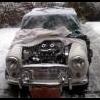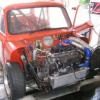Subframe Welding - Mot Failure?
#1

Posted 21 June 2011 - 07:23 AM
1971:
[b]Is a welded subframe considered an MOT failure:
We have a rear dry subframe with some rot on the bottom faces (for which repair sections are available). There is also some rot on the face of the subby where it butts against the heelboard.
I've looked across the www including this forum to find out whether repairing a subframe is permissable in the MOT and I get conflicting views, a number suggesting that the regs tightened in 2003 ish.
Is there anyone that can provide a clearer picture on this?
We intend to do a proper job and correctly seam weld the repair, the subby is currently off the car and easy to work on (no upside down welding and ignoring what you can't see).
It's the difference between £20 of repair panels or £325 of Heritage subby. We're not too keen on pattern s'frames , there seems to be a lot of opinion on build accuracy and use of thinner material.
#2

Posted 21 June 2011 - 09:39 AM
So I would say just repair it if your confident in your welding, MOT man probably won't even notice if its freshly painted and doesn't look like its falling bits.
#3

Posted 21 June 2011 - 09:49 AM
What is frowned upon is just plating over a rotten piece.
#4

Posted 21 June 2011 - 11:49 AM
not correct, any repair panel added to a original panel HAS to be fully seam welded, no spot welds as this is a MOT fail as it causes the panel to be weaker.
#5

Posted 21 June 2011 - 11:57 AM
i think he meant if you putting a plate on thats say 4" by 4" then you seam weld where it buts up against the original metal work and then stick somw spot welds in the middle of the plate for good measure wich would make it as strong if not stronger than originalseam welded where not original join and then spotted where it should be,
not correct, any repair panel added to a original panel HAS to be fully seam welded, no spot welds as this is a MOT fail as it causes the panel to be weaker.
#6

Posted 21 June 2011 - 01:14 PM
seam welded where not original join and then spotted where it should be,
not correct, any repair panel added to a original panel HAS to be fully seam welded, no spot welds as this is a MOT fail as it causes the panel to be weaker.
I know this is what the regs say, But, if you replace a panel, as originally fitted, and it looks like the original panel, AND you know it is as strong, what's the problem? also, if it looks original, who's to say it isn't?
From personal experience, if a subframe needs welding, it's time to chuck it in the bin. the rust is rarely just in one small spot.
#7

Posted 21 June 2011 - 04:23 PM
regards, ( I know this is what the regs say, But, if you replace a panel, as originally fitted, and it looks like the original panel, AND you know it is as strong, what's the problem? also, if it looks original, who's to say it isn't?)
its not me who makes the rules, if you have a very fussy tester who decides to look further than most MOT testers will, then its a fail, so do it correct the first time then he cannot fail it.
if you mean replacing a full panel as originaly fitted then yes it can be welded and spot welded etc as original and thats fine, but if you cut a piece out and weld a new bit in then it has to be seam welded.
as a example, if you cut out the front drivers floor section with the inner sill part and replace it with the normal repair section were it would have been spot welded to the toe board and door step panel, under the MOT rules it has to be seam welded, but who does, most people would just run a few welds along those two areas.
if the tester was very fussy it would fail. so do it once correct for MOT and he would have no reason to fail.
#8

Posted 21 June 2011 - 07:34 PM
The "if theres rust in one part there's likely to be rust in another" is a valuable truism which we will follow.
Thanks for the distinction about where spot and seam welding is appropriate for other parts of the resto also.
1 user(s) are reading this topic
0 members, 1 guests, 0 anonymous users
















